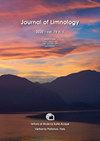利用高频监测和卫星图像评估浅富营养化湖泊叶绿素-a动态
IF 1.1
4区 环境科学与生态学
Q4 LIMNOLOGY
引用次数: 2
摘要
全球淡水生态系统正面临着文化富营养化的挑战,在不同的时空尺度上实施水质监测以控制和缓解富营养化过程是水资源管理者的首要任务。浮游植物丰度是反映湖泊营养状况和水质状况的重要指标。浮游植物动态的特点是在物理、化学和生物因素的驱动下具有高度的时空变化,这对常规采样技术(即基于船的采样)的常规监测能力提出了挑战,无法描述这些复杂的关系。本文利用高频原位测量和多光谱卫星数据,协同研究了曼图亚湖浅水湖系统浮游植物丰度指标叶绿素-a (Chl-a)浓度与水体理化参数的时间(日和季节)动态和空间分布。遥感数据反演的Chl-a与多参数探针记录的Chl-a荧光数据吻合较好(R2 = 0.94)。Chl-a地图允许将曼图亚湖泊系统按季节分类为富营养化或肥厚化。在曼图亚湖泊系统中,Chl-a浓度随河流系统向湖泊系统的转变而逐渐增加。各子流域间存在明显的季节异质性,这可能是由于不同的水动力所致,同时也受大型植物林分的影响。高频数据揭示了降雨事件对浮游植物生长的时间和动态的重要性,特别是对春季和夏末的开花。高分辨率时空数据的结合提高了对复杂河流-湖泊系统的认识。这项技术可以让管理者在花在整个系统中的移动过程中近乎实时地瞄准花,并将它们引导到局部热点,从而在具有高保护和娱乐价值的生态系统中及时采取管理行动。本文章由计算机程序翻译,如有差异,请以英文原文为准。
Exploiting high frequency monitoring and satellite imagery for assessing chlorophyll-a dynamics in a shallow eutrophic lake
Freshwater ecosystems are challenged by cultural eutrophication across the globe, and it is a priority for water managers to implement water quality monitoring at different spatio-temporal scales to control and mitigate the eutrophication process. Phytoplankton abundance is a key indicator of the trophic and water quality status of lakes. Phytoplankton dynamics are characterized by high spatio-temporal variation, driven by physical, chemical and biological factors, that challenge the capacity of routine monitoring with conventional sampling techniques (i.e., boat based sampling) to characterise these complex relationships. In this study, high frequency in situ measurements and multispectral satellite data were used in a synergistic way to explore temporal (diurnal and seasonal) dynamics and spatial distribution of Chlorophyll-a (Chl-a) concentration, a proxy of phytoplankton abundance, together with physico-chemical water parameters in a shallow fluvial-lake system (Mantua Lakes). A good agreement was found between Chl-a retrieved by remote sensing data and Chl-a fluorescence data recorded by multi-parameters probes (R2 = 0.94). The Chl-a maps allowed a seasonal classification of the Mantua Lakes system as eutrophic or hypertrophic. Along the Mantua lakes system an increasing gradient in Chl-a concentration was recorded following the transition from a fluvial to lacustrine system. There was significant seasonal heterogeneity among the sub-basins, probably due to different hydrodynamics, influenced also by macrophyte stands. High-frequency data revealed the importance of rainfall events in the timing and growth dynamics of phytoplankton, particularly for spring and late summer blooms. Combining temporal and spatial data at high resolution improves the understanding of complex fluvial-lake systems. This technique can allow managers to target blooms in near-real time as they move through a system and guide them to localized hot spots enabling timely management action in ecosystems of high conservation and recreational value.
求助全文
通过发布文献求助,成功后即可免费获取论文全文。
去求助
来源期刊

Journal of Limnology
地学-湖沼学
CiteScore
2.70
自引率
6.20%
发文量
12
审稿时长
3 months
期刊介绍:
The Journal of Limnology publishes peer-reviewed original papers, review papers and notes about all aspects of limnology. The scope of the Journal of Limnology comprises the ecology, biology, microbiology, physics, and chemistry of freshwaters, including the impact of human activities, management and conservation. Coverage includes molecular-, organism-, community-, and ecosystem-level studies on both applied and theoretical issues. Proceedings of workshops, specialized symposia, conferences, may also be accepted for publication.
 求助内容:
求助内容: 应助结果提醒方式:
应助结果提醒方式:


